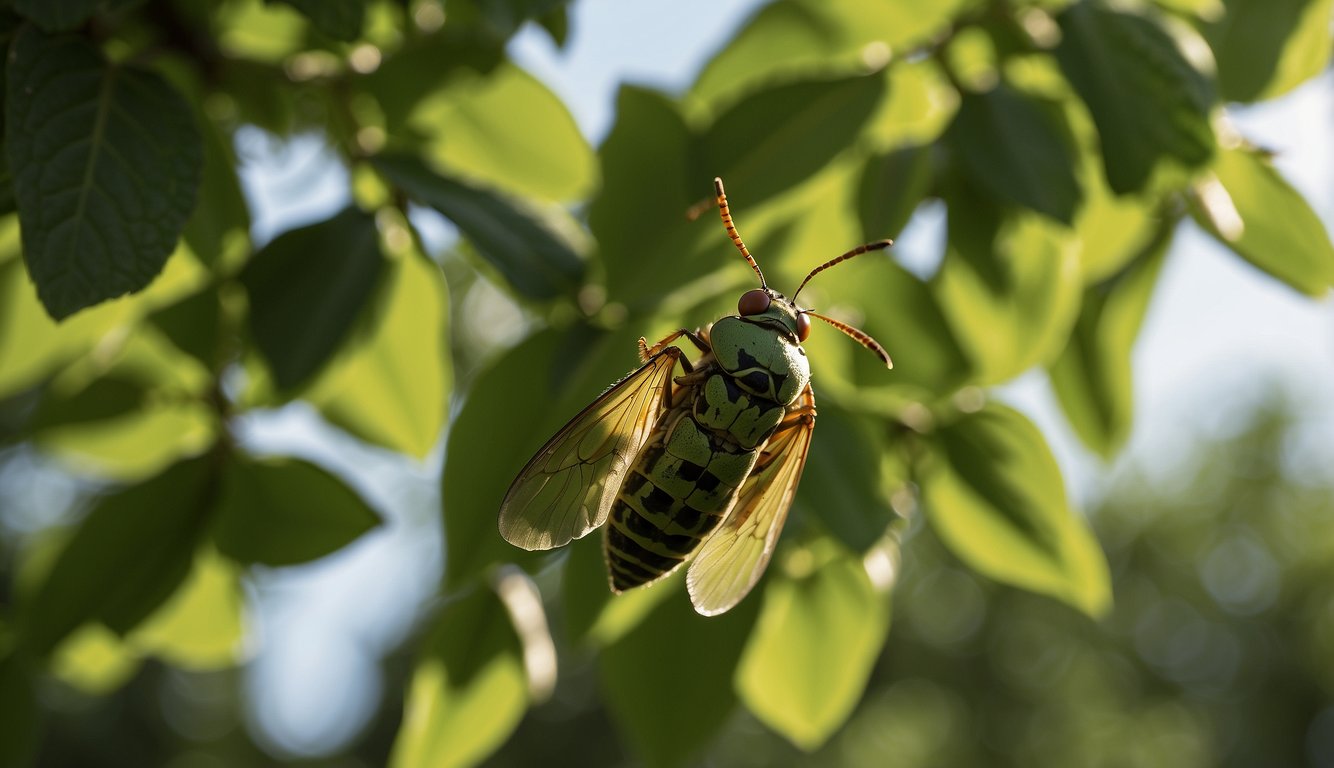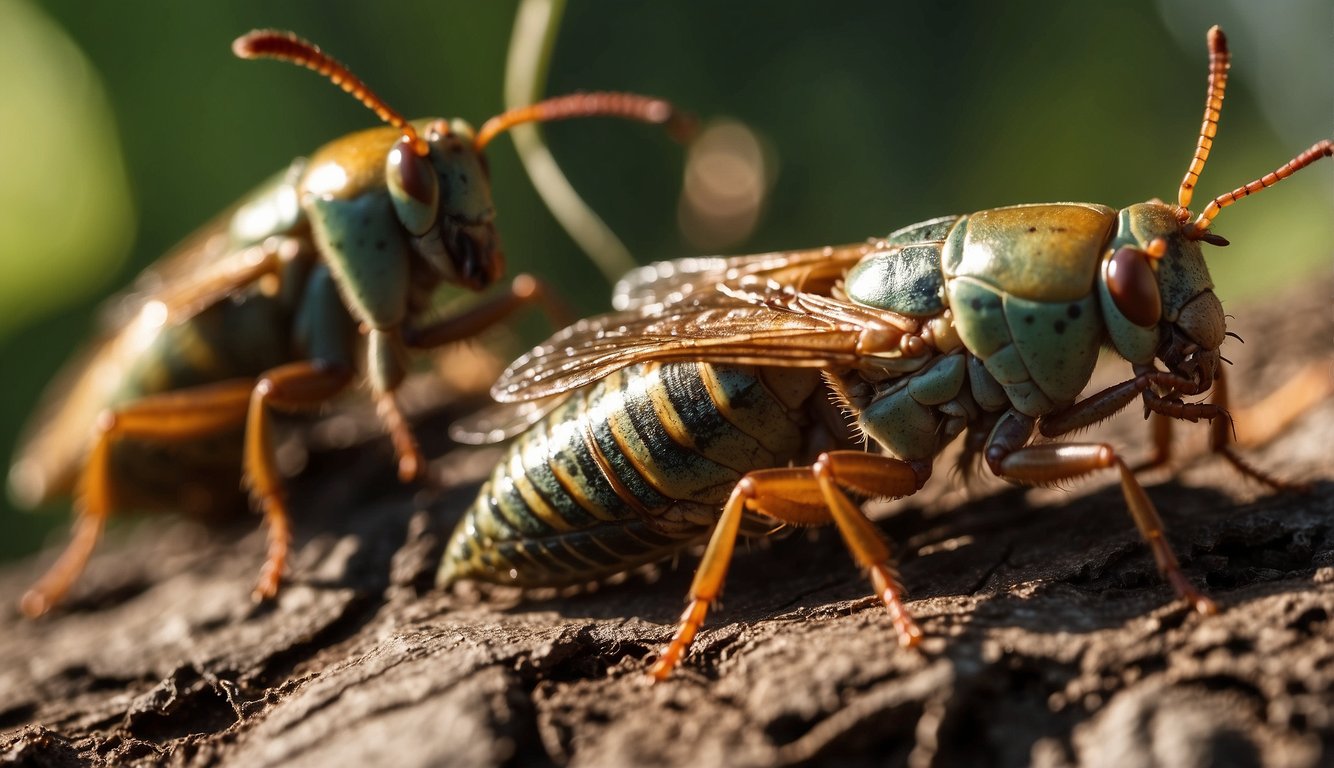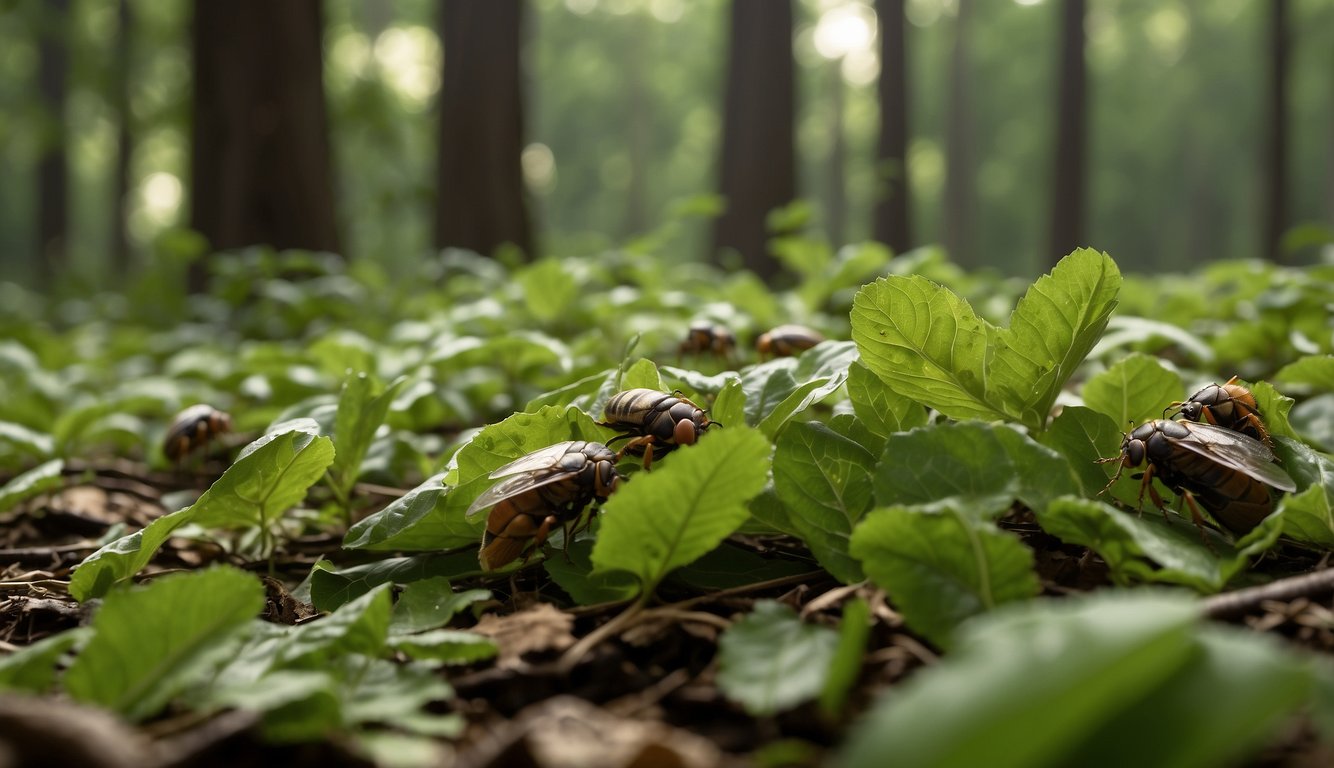Magic of the 17-Year Cycle
Every 17 years, you witness a natural phenomenon that’s as predictable as it is fascinating.
Let’s dive into the remarkable lifecycle of these periodical cicadas and precisely what makes Brood IX’s emergence an event you won’t want to miss.
Cicada Lifecycle
- Birth: Cicadas start as eggs in treetops.
- Nymphs: They grow into nymphs and burrow underground.
- Development: Feeding on sap from roots, they develop for 17 years.
- Emerge: Finally, they surface, molt, and begin their chorus.
Brood IX Emergence
- States Affected: Brood IX emerges in specific regions, such as parts of Illinois.
- Event Timing: Mark your calendars for mid-May; this is when you can expect these cicadas to come to life.
The dual emergence of Brood IX represents a unique overlap that occurs rarely, a spectacle ensuring states like Illinois are in for an unforgettable experience.
This convergence is not just a whimsical event but an ecological marvel you can anticipate with both curiosity and amazement.
Cicada Spotting Tips
As the cicadas emerge in 2024, finding the perfect spot and time can lead you to the heart of this natural phenomenon. Here’s how you can make the most of your cicada adventure!
Prime Locations
To witness the incredible emergence of periodical cicadas, target regions where Brood XIX and Brood XIII overlap, particularly in north-central Illinois.
Additionally, keep an eye on areas like most of Illinois in May and June for a vibrant display.
- Illinois Hotspots: Springfield and surrounding central regions are prime for spotting Brood XIX.
- Overlapping Broods: Certain parts of north-central Illinois offer a rare chance to see both broods.
For more detailed mapping, consider using resources like cicada invasion maps to pinpoint your target area.
Timing Your Adventure
Maximizing your experience means hitting the right timing.
Cicadas are typically most active when the ground temperature reaches about 64°F.
- Best Months: May and June are peak months for cicada activity.
- Daily Peak Times: Aim for warm afternoons when cicadas are most visibly active.
Check resources such as The Morton Arboretum to find more specific emergence timings in Illinois.
Cicada Songs and Signals
If you’re tuning into the symphony of the great outdoors this season, you’ll likely hear the distinct serenade of periodical cicadas. These soundscapes aren’t just random noises; they’re vital for cicada survival and species identification.
Mating Calls Explained
The loud buzz you hear is the male cicada’s love song, aimed at wooing the often silent females. Here’s the scoop on these siren calls:
- Frequency: Ranges from a low buzz to high-pitched tones.
- Purpose: Each species has its mating call to attract the right match.
- Volume: Can exceed 90 decibels – that’s as loud as a lawn mower!
Cicadas are the virtuosos of the insect world, with different species having distinct calls, which females listen to and respond with wing-flicks as a form of acceptance.
Identifying Species by Sound
You don’t need to be an entomologist to tell these insects apart; your ears can be your guide. Check out how to identify a couple of species by their unique sound profiles:
- Magicicada septendecim
- Call: A high-pitched “Pharaoh” song
- Region: Eastern U.S.
- Magicicada cassini
- Call: A quick, sharp buzzing sequence
- Region: Central and Southern U.S.
Listen closely, and you’ll start to pick out the different patterns.
A fun fact to remember is that the periodical cicada emergence this year is a rare event, with both 13-year and 17-year broods surfacing simultaneously. This cacophony of sound will help you distinguish between these impressive insects.
Environmental Impact
Hey there! Before you marvel at the cacophony of the 2024 cicada emergence, let’s buzz through how these critters will shape the green world around you.
Ecosystem Roles
- Soil Aeration: When cicada nymphs tunnel their way out of the earth, they naturally aerate the soil. This makes it easier for water and nutrients to reach plant roots.
- Nutrient Recycling: Spent cicadas become a free, all-natural fertilizer, breaking down to replenish the soil with beneficial nutrients.
Cicadas can also [rewire our ecosystems] by providing a bounty of organic matter that influences plant growth and soil health for years.
Cicada Predation
- Feast for Wildlife: Birds, fish, and other wildlife will gorge on the cicada bonanza, bulking up their populations.
- Population Control: By the sheer number of cicadas surfacing, not all will survive predators, ensuring a balanced check on their numbers.
Cicadas are not just snacks; they’re a [critical part of the food web] that supports a multitude of creatures.
Grab your binoculars, because you’re in for a spectacle that doubles as an environmental transformer!
Cicada Celebration
The 2024 periodical cicada emergence offers unique festivities and flavorful experiences you won’t want to miss. From community gatherings to taste tests, prepare to join in the excitement.
Festivals and Events
- Cicada Watch Parties: Grab your binoculars and join local enthusiasts in parks and nature reserves as you witness this once-in-a-17-year event.
- Educational Workshops: Learn about cicada biology and their impact on the ecosystem at interactive seminars hosted by universities.
Culinary Delights
- Cicada Cooking Classes: Discover how to safely prepare and cook these protein-packed insects with the guidance of expert chefs.
- Exotic Tasting Menus: Sample cicada-infused dishes at participating restaurants, featuring everything from appetizers to desserts.
Frequently Asked Questions
Get ready to uncover the buzzing world of periodical cicadas with these straight-to-the-point FAQs!
When can we expect to see the emergence of periodical cicadas?
- You can expect periodical cicadas to start surfacing in early to mid-May, depending on the soil temperature and your specific location.
What are the distinctive features of periodical cicadas?
- Periodical cicadas are known for their four wings and tube-like mouthparts. They are not to be confused with locusts, which are a different order of insects.
How do periodical cicadas impact the local ecosystem during an emergence year?
- These insects aerate the soil, provide a food source for wildlife, and their decaying bodies enrich the soil with nutrients after they die.
What’s the lifespan of periodical cicadas, and how much of that is spent underground?
- Periodical cicadas live up to 17 years, with as much as 17 years spent underground.
Are there any natural predators that affect periodical cicada populations?
- Birds, small mammals, and even fish feast on cicadas, naturally regulating their populations.
How should one prepare their yard or garden for a periodical cicada emergence?
- Protect young trees with netting.
- Delay new plantings until the cicadas have died off to minimize damage to your yard or garden.


